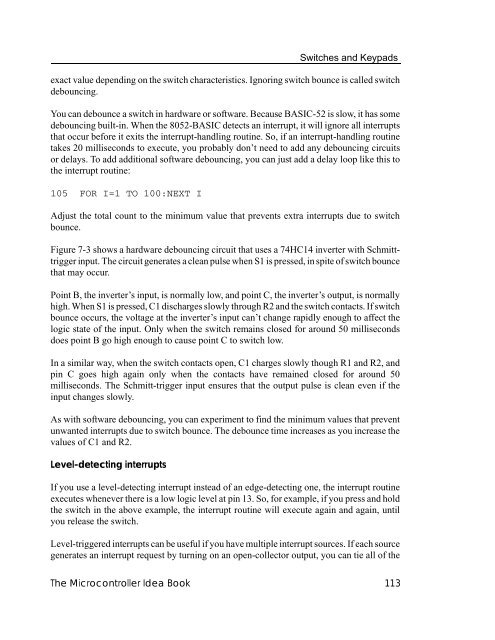The Microcontroller Idea Book - Jan Axelson's Lakeview Research
The Microcontroller Idea Book - Jan Axelson's Lakeview Research
The Microcontroller Idea Book - Jan Axelson's Lakeview Research
You also want an ePaper? Increase the reach of your titles
YUMPU automatically turns print PDFs into web optimized ePapers that Google loves.
exact value depending on the switch characteristics. Ignoring switch bounce is called switch<br />
debouncing.<br />
You can debounce a switch in hardware or software. Because BASIC-52 is slow, it has some<br />
debouncing built-in. When the 8052-BASIC detects an interrupt, it will ignore all interrupts<br />
that occur before it exits the interrupt-handling routine. So, if an interrupt-handling routine<br />
takes 20 milliseconds to execute, you probably don’t need to add any debouncing circuits<br />
or delays. To add additional software debouncing, you can just add a delay loop like this to<br />
the interrupt routine:<br />
105 FOR I=1 TO 100:NEXT I<br />
Adjust the total count to the minimum value that prevents extra interrupts due to switch<br />
bounce.<br />
Figure 7-3 shows a hardware debouncing circuit that uses a 74HC14 inverter with Schmitttrigger<br />
input. <strong>The</strong> circuit generates a clean pulse when S1 is pressed, in spite of switch bounce<br />
that may occur.<br />
Point B, the inverter’s input, is normally low, and point C, the inverter’s output, is normally<br />
high. When S1 is pressed, C1 discharges slowly through R2 and the switch contacts. If switch<br />
bounce occurs, the voltage at the inverter’s input can’t change rapidly enough to affect the<br />
logic state of the input. Only when the switch remains closed for around 50 milliseconds<br />
does point B go high enough to cause point C to switch low.<br />
In a similar way, when the switch contacts open, C1 charges slowly though R1 and R2, and<br />
pin C goes high again only when the contacts have remained closed for around 50<br />
milliseconds. <strong>The</strong> Schmitt-trigger input ensures that the output pulse is clean even if the<br />
input changes slowly.<br />
As with software debouncing, you can experiment to find the minimum values that prevent<br />
unwanted interrupts due to switch bounce. <strong>The</strong> debounce time increases as you increase the<br />
values of C1 and R2.<br />
Level-detecting interrupts<br />
Switches and Keypads<br />
If you use a level-detecting interrupt instead of an edge-detecting one, the interrupt routine<br />
executes whenever there is a low logic level at pin 13. So, for example, if you press and hold<br />
the switch in the above example, the interrupt routine will execute again and again, until<br />
you release the switch.<br />
Level-triggered interrupts can be useful if you have multiple interrupt sources. If each source<br />
generates an interrupt request by turning on an open-collector output, you can tie all of the<br />
<strong>The</strong> <strong>Microcontroller</strong> <strong>Idea</strong> <strong>Book</strong> 113






